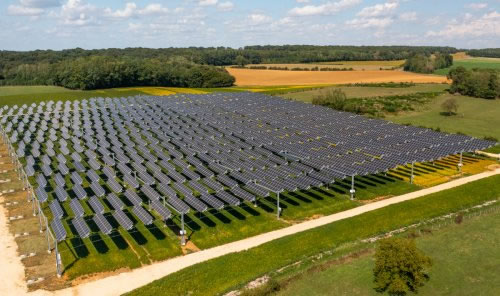TSE's agricultural canopies: PcVue at the heart of a system of photovoltaic shades

Transitioning to sustainable energy sources is the major challenge of our era. Emission reduction, optimization of consumption, clean energy that is accessible to all, and de-carbonization are some of the challenges to be met in order to preserve the environment and combat energy insecurity.
Faced with these many challenges, a host of initiatives for a new, more robust and sustainable energy model are emerging. One of these is agrivoltaics, a system that produces energy using both renewable energy sources and agricultural crops.
Photovoltaics for agriculture
The concept is simple, photovoltaic panels are installed on barn roofs and other agricultural structures. They are designed for integration with the grid in a rural environment. Farmers can then produce their own energy at lower cost and without impairing their agricultural production.
TSE is one of the main independent players in solar energy in France. The company was founded more than ten years ago to develop solar power stations and agrivoltaics solutions that transform solar energy into electricity.
TSE supports their customers and partners in building the solar power station´s complete value chain starting from design through financing, construction, supervision and operational management.
In 2022, TSE inaugurated its first agrovoltaics pilot site in 3 hectares located in Amance, France. A photovoltaic shading system with a capacity of 2.4 MWp, equivalent to the power consumption of a community of 1,350 inhabitants, it is installed on large-scale crops of soya, wheat, forage rye, winter barley and rapeseed.
The project came into being because of production limitations on the farm. It had been suffering from very hot and arid summers for more than a decade. The agricultural canopy, developed by TSE, was chosen by farmers because it is designed with rotating shades. These shades enable the system to mitigate climatic conditions in the summer season by lowering the temperature under the shade.
Installation of the agricultural canopy in Amance
The agricultural canopy is composed of a large shading structure equipped with solar panels with tracker systems fixed on cables 5 meters above the fields. A supervision system is also provided to control the orientation of the panels, depending on the weather conditions, and to completely automate the acquisition of operational data.
After carrying out a market study, the Data & Optimization Division of TSE selected the PcVue platform to implement the SCADA (Supervisory Control & Data Acquisition).
Among the decisive criteria for choosing the PcVue platform, in preference to several other competitors, was the ability to have complete control over the platform, the ease of development, leveraging a dedicated solar solution supplied with the platform and, the quality of service from the technical support team.
On site, the supervision system manages a database of 25,000 data points. An optimized display enables alarms to be quickly understood by operators, supporting rapid problem resolution. The architecture features a central controller with PcVue acting as the data acquisition server. This system provides the link with all the solar transformation equipment as well as with several NCUs (Network Control Units) for the control and tracking of each of the 612 solar tables that make up the canopy structure.
Specific controllers handle high frequency data acquisition rates down to 10 milliseconds sampling. This is done in order to supply mathematical models running in real time. This very precise data is also used to determine how the system will response under specific conditions of interest.
TSE has formed a partnership with the Ecole des Mines, of PSL Research University, to work on some of the subjects related to photovoltaics. The remainder of the research and development is performed internally. For example, multiple tests are carried out from the photovoltaic station to ensure that factors such as cable tension, potential erosion of the system of cradles, etc., do not impact durability of the station.
The pilot project at the Amance site is the first 9-year demonstrator for TSE. TSE is the specialist in solar energy has 3 similar projects under construction and 12 other pilot projects in the development phase (construction planned for completion 2024-2025).
www.pcvuesolutions.com
Comments (0)
This post does not have any comments. Be the first to leave a comment below.
Featured Product

